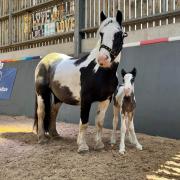The niece of a largely forgotten Manchester artist is fighting to restore his reputation. An exhibition being staged in Salford should help. Words by Paul Mackenzie

When Sue Astles was growing up in the 1960s she used to long for the occasional visits her uncle made to her family home. When she saw his car outside the house as she walked home from school, her heart would leap. ‘He was just so with it,’ she said. ‘He’d be wearing coloured shirts he’d bought in Carnaby Street and his wife Susie would make her own Mary Quant style dresses. They used to buy me Beatles EPs and we’d play them really loud. My mum and grandmother weren’t impressed, but for me as a teenager it was brilliant.’
The avant garde uncle was Harry Ousey, an abstract artist who was largely forgotten after his death from cancer in a French hospital in 1985. But Sue is now working hard to establish her uncle’s reputation.
‘I have been told that his work is very important in the 20th century British art scene and I just want him to be remembered, as he should be,’ Sue said. ‘I realise he’s never going to be really famous but it’s just about bringing him back and that’s what I will continue to work at.’
Sue’s work reached a milestone when an exhibition opened at the end of March at Salford Museum and Art Gallery to commemorate the centenary of Harry’s birth. At that gallery in 1948, a panel including LS Lowry selected one of Harry’s paintings, Landscape near Hayfield, to appear in their Local Artists exhibition.
‘It was an emotional moment when the exhibition opened, I’d expected to be a blubbering idiot. There were people there who knew him and people who have some of his work. There have been exhibitions before but this was extra special because we were walking through the same doors as Harry and Susie in 1948.’
Harry was born in the Longsight area of Manchester in 1915 and knew from an early age he wanted to paint but he was repeatedly told to get a proper job and after his father died, Harry moved to London in the 1930s to study architecture. The city though was full of artists, many of whom had fled Europe as the threat of war increased.
He spent much of his spare time touring the capital’s galleries and having met a number of artists at exhibitions including the first Surrealist art show in the country, his determination to join their ranks hardened.
Although Harry had had no formal art training – he did attend occasional classes in Manchester and Salford in his youth – he began to experiment with techniques and styles but all his early work was destroyed in a bombing raid.
In 1942, Harry married Eleanor Maden from Rawtenstall – known as Susie – and after the war the couple moved to Hayfield in the Peak District where he began to paint in earnest.
After the 1948 exhibition in Salford, the couple moved to Cornwall and, in the early 1960s, to London where Harry’s star really began to rise. He exhibited his work and was reviewed in national newspapers and art journals, but with the rise of Pop Art and a growing sense of disillusionment with the British art scene Harry and Susie moved to France where they believed his work would be taken more seriously.
They settled in Provence where Harry created work that was exhibited across Europe and he was working on a major show in Paris right up until his death in 1985. Susie returned to England but couldn’t bear to unpack her husband’s paintings and they remained in storage until her death in 1997. Today, some of Harry’s pictures can be found for sale, normally for under £1,000.
Sue added: ‘Unbeknown to us Susie had all his art packed away in the house. We brought it all back and started to unpack it and it was such a revelation to me.
‘It almost spoke to me, I can’t explain it. I certainly wasn’t going to just put it in the loft so I started researching Harry’s life and work.
‘Reading his diaries, it’s clear that he was so driven – he had to paint and to pursue whatever it was that drove that need.’
The research was a pleasant distraction for Sue who had recently been diagnosed with breast cancer. ‘It has been a labour of love and it kept me going while I was going through all the treatment at Christie’s,’ she said.
Now fully recovered, Sue, a former florist, has her uncle’s diaries and notebooks as well as many hundreds of his paintings, but many more were given away or loaned to friends when Harry didn’t have room to store them all.
And Sue, who is now 65 and lives in Glossop, said: ‘People have contacted me to say they have got some of his work. It is so intriguing and although much has been revealed along the way, I know that there are some mysteries that will never be solved.
‘It has been as though someone took me by the hand and led me in this direction. I don’t really know where it will lead but I just want his name to be established in the British art scene.’ w
One Needs More Than Paint, A Centenary exhibition Of Harry Ousey, runs until July 5 at Salford Art Gallery.



























